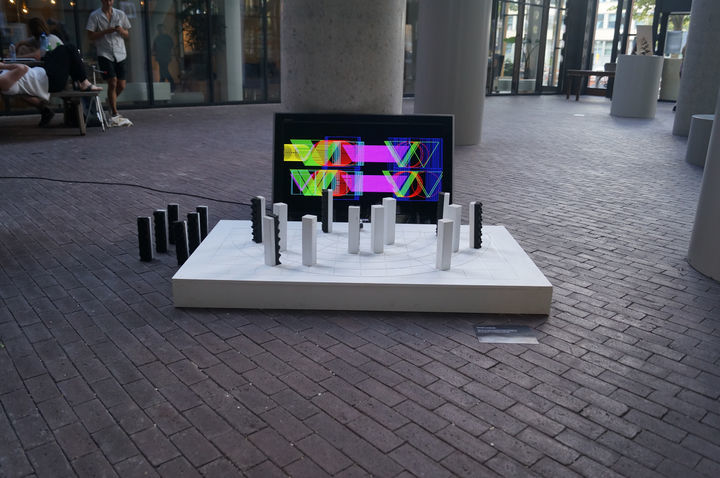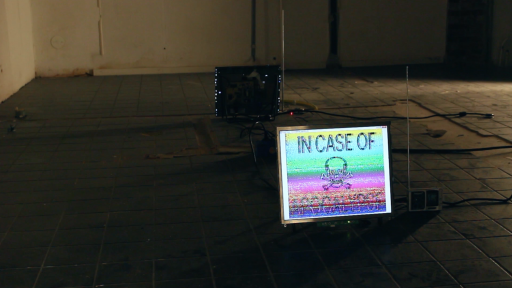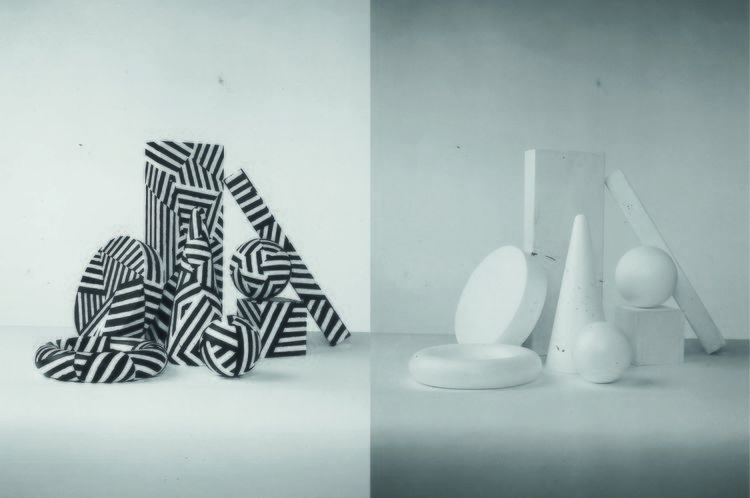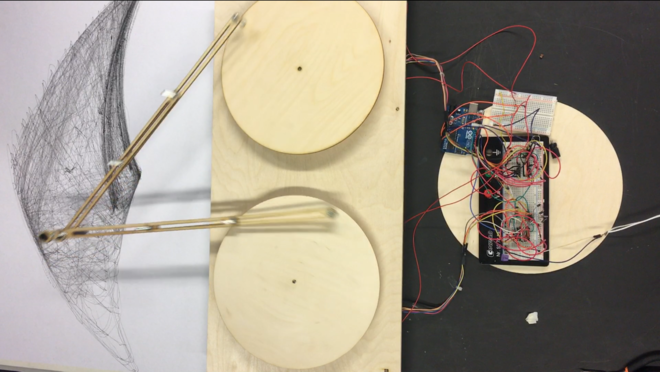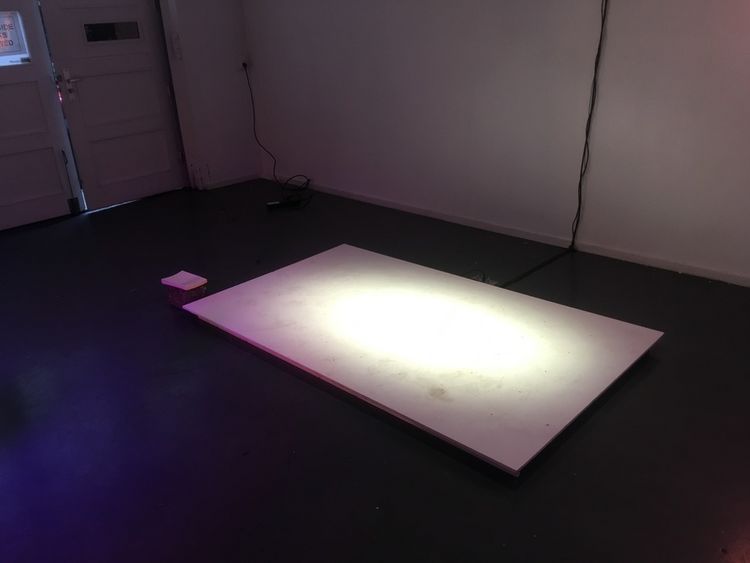Difference between revisions of "User:KvdH/Research Doument"
| Line 32: | Line 32: | ||
'''Plotter Algorithm''' <br> | '''Plotter Algorithm''' <br> | ||
| − | [[File: | + | [[File:IMG_0960.PNG|thumb|right|upright=2.2|alt=A large clock tower and other buildings line a great river.]] |
This project was about algorithms, I worked alone on this project. The idea of this project started when I visited the Stedelijk Museum in Amsterdam. I saw there an exhibition from Jean Tinguely. I think that was the best exhibition I saw in the last year. In the works of Jean Tinguely repetition is very important. The installations of Tinguely move every 5 minutes. Due to the continuity of the movement you see the wear. I think those tracks of damaging are very interesting and show a sort of algorithm. Other works of Tinguely are the plotters who are randomly drawing on a piece of paper. By rotating a lever you activate the plotter. The outcomes of the plotter are random drawings with some kind of repetition, it is sort of an algorithm. Based on this knowledge I want to make also a plotter who is reacting on his surrounding. I build a machine who is reacting on the light intensity by using two sensors. The machine had two who were holding a pen. The arms were attached to a rotating disk. The rotation speed of each disk depended on the light intensity of each sensor. The drawing what is appearing is a sort of mapping of the surrounding. If the light is constantly the same the pen will draw the same line over and over again but if one sensor changes the whole line will change. For me, this work was just a starting point and I was not satisfied with the outcome. It could have had more depth and more focus on what the surrounding is and which effect people have in a space. | This project was about algorithms, I worked alone on this project. The idea of this project started when I visited the Stedelijk Museum in Amsterdam. I saw there an exhibition from Jean Tinguely. I think that was the best exhibition I saw in the last year. In the works of Jean Tinguely repetition is very important. The installations of Tinguely move every 5 minutes. Due to the continuity of the movement you see the wear. I think those tracks of damaging are very interesting and show a sort of algorithm. Other works of Tinguely are the plotters who are randomly drawing on a piece of paper. By rotating a lever you activate the plotter. The outcomes of the plotter are random drawings with some kind of repetition, it is sort of an algorithm. Based on this knowledge I want to make also a plotter who is reacting on his surrounding. I build a machine who is reacting on the light intensity by using two sensors. The machine had two who were holding a pen. The arms were attached to a rotating disk. The rotation speed of each disk depended on the light intensity of each sensor. The drawing what is appearing is a sort of mapping of the surrounding. If the light is constantly the same the pen will draw the same line over and over again but if one sensor changes the whole line will change. For me, this work was just a starting point and I was not satisfied with the outcome. It could have had more depth and more focus on what the surrounding is and which effect people have in a space. | ||
<br> | <br> | ||
Revision as of 17:03, 23 January 2017
Who am I?
I’m a visual designer, who is exploring more media to work with, at the moment I’m working a lot with sound/music. I think exploring more media or materials is important to broaden your horizon and to learn new things. If have a big interest in music so at the moment I try to combine my visual design with my passion and interest for music. I make quite often my own tools or technologies to realize my projects. Most of the time I have t take myself because it doesn’t exist or it is too expensive. By doing it yourself I have the control over all the things I do and the same time I learn new things about for example codes, technique, and electronics. Through the acquired technical knowledge nothing seems impossible. There will be always a way to build something that can help to realize the thing I want. It that way I’m a visual designer but I have also the skills a knowledge to realize technical projects were the technical part is important. I’m capable of making graphic/visual work and that will stay my base of making works. In the last project that visual part changed. I worked with sound as material, a sound is not visible, from now on I want to focus more on working with sound. For me it is interesting to work as the visual designer with something that is not visible, is that possible? I will later expand further on this question.
I worked a lot with electronics in the last view months; Raspberry Pi, Arduino, Processing, soldering, transistors, led’s etc.. I used these things to make it possible to design or to create visual work. For example, the sonar tool I made during the first-week project. I made a tool who send acoustic radiation waves into space. When the waves bump up against an object the wave goes back to the sensor and receive the distance of the object. Each distance had his own shape and color. On a screen, you saw the shapes appear in a vertical movement. In this example, it is important to mention that the tool I made is essential for the outcome of the work. With this in mind, I think that my medium is the way I work and how I use the possibility I can create myself. The two actions need each other to make visual work. The Interaction Station is an important place in this process, there are enough space and facilities to create and to test your ideas. Also, the practical facilities are available and it makes it possibly realize your ideas.
I think the future will bring more and more new tools and media to work with, it will be difficult to know all these new developments and to stay updated. I think it is important to concentrate on the developments who are interesting for me as a designer and for the themes and subject, I working with. For example the developments in VR. Sometimes I’m worried about the fast developments in te digital and visual possibilities in the design world, it’s difficult to stay up to date and to monitor all the new developments. I can’t say fast development is a bad thing because it gives a lot of new media to work with and that is positive. An example of a new development is the possibility to create a virtual world or the access to a lot of information/data that we can use as an information source. So I have to follow up on specific developments, for this moment is that sound. There will be continuously new mediums and developments, what is very exciting and gives so many possibilities. If you keep challenging yourself with these new mediums I think there are no borders in this practice unless you stop being curious. I think being curious is valuable as a mentality to expand knowledge and to keep producing work. Curiosity leads to more depth in a research, I want to know everything when I'm curious and enthusiastic. It gives motivation.
I think my specific digital craft skills are a combination of different things; curiosity in new media, subjects, and materials. Being interested and capable of working with electronics and digital stuff. Using my aesthetic skills to make . And last, I challenging myself with new questions and subjects to work with for example sound as a material. I want to focus on subjects who are reliable to my own interests and fascinations. My work is mostly in installation form were a spectator has to experience something. Working with the thoughts of a spectator and try to control or influence. Give the process out of hands and let the spectator decide what to do.
Minor Projects
Acoustic Landscape
How do we explore sound and space? Through our dynamic visual we attempt to understand the relation of objects in an acoustic landscape.
In this first week project, we had to work for the first time with the theme radiation. I worked together with Nora Mabrouki, Koen van Geel en Judith van der Heiden. Our focus was acoustic radiation. We did an extensive research into sound waves and acoustics. We worked with a material what was not something tactile or something you can see. That was the reason to work from here on with something that had the possibility to make sound waves visible and editable. We used a sensor which makes use of high sounds that bump up against an object and will return to a sort of microphone. The time that the sound is traveling tells us the distance from the sensor to the object. With this in mind, we want to make it editable, the spectator had to be a part of the installation. We made a plateau with a grid, on this plateau, there were multiple little pillars. The sensor was linked to a computer and a screen. By moving the pillars over the plateau there were different shapes and colors appearing on the screen. So by changing the position of the pillars and in that also the acoustic surrounding of the sensor the image on the screen changed every time. This project brought a lot off insights about how to work with materials or subject who are not tactile or seeable. For example the translation from sound to visible images. The process of making a tool to create those visible images is a really interesting and important for the rest of the minor.
Slow Scan Image
Important aspects of communication are speed and precision. We all want the best image quality and fastest signal. But what about older techniques that never made it to the big audience because of a lack in these fields? With Slow Scan Image, we're looking into a way we can alter signals to control faults in the system, creating a new design tool. In this project, we focused mainly on an old communication technique and used this in a different perspective.
This project was about electromagnetic waves or radio waves. I worked together with Stijn van Ardenne en Boris Smeenk. SSTV is an old technique what was used by the navy and astronauts to communicate with visual content. By translating pixels into frequencies you can send it just like radio, when you decode the frequencies on the receiver side there will be appearing an image. When there is a lot of noise when you sent the image, the image will be damaged or there will be glitches in the image. Our approach was to compare the quality of the SSTV with the need of tv.s with perfect quality. The way the SSTV communicates is terribly slow, so you have to wait a couple of seconds to see the image appearing on the screen. We started the project by building a simple radio with a raspberry pi. It was exciting to see how a radio sends content through radio waves. When we had a working radio station we decided that we need to make another step. We did some research on different sending techniques. The most spectacular were the SSTV because of the way the SSTV load their images. We used a program that decodes the frequencies, later on, we build our one receiving station.
Dazzled Patterns Dazzle Camouflage (WW1 camouflage technique) makes it hard to estimate the distance and movement direction of an object. In normal cases, the overlay will give more depth but with dazzled camouflage overlay will give less depth. Can we use this technique to mislead the depth and perspective in a still-life of geometric objects?
This project was about light radiation, I worked together wit Stan Haanappel. We want to do something with how light felt on objects, how we see an object. How do we see light and the movement of light? If you look at an object you can see how light bends around an object. A straight grid will get round lines if you beam it on an object, we though that phenomenon was very interesting. We did several tests; We beamed lines on objects, we tried to capture the lines with the Kinect. But all these things doesn’t come to an interesting point. We start to do more research and we found a camouflage technique from WW1. Dazzle Camouflage (WW1 camouflage technique) makes it hard to estimate the distance and movement direction of an object. In normal cases, an overlay will give more depth but with dazzle, camouflage overlay will give less depth. Can we use this technique to mislead the depth and perspective in a still-life of geometric objects? In this project, we were looking for a way to mislead or manipulate light. We wanted this because light or reflection is the base of seeing. Our brain processes the information and gives us an image of the surrounding. We want to try to manipulate that process. We tried several ways to complete that goal. First, we tried to use different patterns by beaming it on objects, that doesn’t work because you can’t beam on the back of an object. After that, we started to paint the beamed lines on the objects. So when you moved te object the lines were strange from a different angle. After this, we found the dazzled camouflage and tried that technique. This worked quite well. It is difficult to separate the different objects from each other. We decided to make a sort of still live with de objects. We want this because in still lives was light or reflection one of the important things. We made a series of photo's, this was the end result of this project.
Plotter Algorithm
This project was about algorithms, I worked alone on this project. The idea of this project started when I visited the Stedelijk Museum in Amsterdam. I saw there an exhibition from Jean Tinguely. I think that was the best exhibition I saw in the last year. In the works of Jean Tinguely repetition is very important. The installations of Tinguely move every 5 minutes. Due to the continuity of the movement you see the wear. I think those tracks of damaging are very interesting and show a sort of algorithm. Other works of Tinguely are the plotters who are randomly drawing on a piece of paper. By rotating a lever you activate the plotter. The outcomes of the plotter are random drawings with some kind of repetition, it is sort of an algorithm. Based on this knowledge I want to make also a plotter who is reacting on his surrounding. I build a machine who is reacting on the light intensity by using two sensors. The machine had two who were holding a pen. The arms were attached to a rotating disk. The rotation speed of each disk depended on the light intensity of each sensor. The drawing what is appearing is a sort of mapping of the surrounding. If the light is constantly the same the pen will draw the same line over and over again but if one sensor changes the whole line will change. For me, this work was just a starting point and I was not satisfied with the outcome. It could have had more depth and more focus on what the surrounding is and which effect people have in a space.
Final Project Minor
The installation “Acoustic surroundings” is about the consciousness about sound in our surrounding and how it is controlled by our position in a space or surrounding. We can't see sound, we can only hear it. In this installation, movement through space affects the outcome of the sound(waves). The spectator will experience that his movement affects the sound.
In my final project, I focused on the acoustic radiation, music and sound are two big influences in my life. I’m musician and I have a big interest in music and how music and sound works. I want to focus on the existence of sound in a space. How does acoustics work? How do people react on the acoustics in a space? Are people aware of acoustics or is it something we learned to deal with? Can I manipulate or influence that phenomenon? My research started by monitoring my own behavior focused on acoustics, I mentioned when I was in a big open space with a lot of noise I was less concentrated and it was difficult to focus on the specific sound. When I was in a small and closed space and I could hear someone really loud and clear, I was more concentrated and it was less difficult to focus. Of course that phenomenon, not a surprising conclusion, in the big space there were more sound sources than in the small space. The striking thing was that my brain changed in every setting, in the noisy space my brain tried to focus on the specific sound source and tried to filter out the rest of the noise. This is happening without control. So your brain adapts to different environments. That phenomenon is very interesting. I started researching the more scientific side, how do your ears communicate with your brain and how do we focus? The answer to this question sound simple we just turn our head to the source. But that's not all we are able to distinguish different sounds, we use our eyes to separate the different sound sources. We combine our ability to see with our ability to hear. Those two elements give us the possibility to focus on one sound source in a noisy surrounding.
After this researching, I started working on a concept what was based on the phenomenon I mentioned before. Your brain expects a sound in a space, for example when you walk into a big church you expect that the sound is echoing. If I can change the sound people expect to hear in a space I can try to make sound tangible and create some consciousness of the phenomenon; Sound. I want to give the spectator the chance to explore the space, so the spectator will have a leading role.
I started searching for a way to let the spectator control the sound in a space. I had to work with microphones to record the sound of the space, to get a live control of the sound. There had to be something that can be triggered by the spectator. First I started working with the Kinect sensor, I worked a lot with the Kinect so that was quite comfortable. So I used the Kinect to trace the movement of a passing person this was activating a program what was linked to the input of the microphone. The sound changed into the acoustics of an enormous room whit a lot of echo en delay. The first test worked good but the Kinect was a limiting the possibilities. The Kinect is only able to see a linear line and was not precise enough. I had to find another way. For another project, I used a light sensor for activating something, so I started working with a light sensor. I had to find something to constantly activate the sensor to make it accurate, I tried a laser, this worked quite well and was reliable. I thought of two walls within the first wall sensors and in the other the lasers. The walls were 1,20m x 2,20m and I made a grid with 40 holes. In every hole a laser or a sensor. If I would put the walls facing each other the laser would activate the sensors. And if someone was interrupting the laser light it activated an effect. But later on it was not working, the lasers were too precise to focus on the sensors, every little deviation was seeable. This was happening a week before the opening of the exposition. I decided to put the wall with the sensors on the ground so you could walk over it. By putting your feet on the holes you will take the light away. So if the sensors had not much light someone was stepping on one of the holes and the effect was triggered. It was quite different in comparison with the first ideas were the walls were part of the room and not a noticeable object. Now it was more like a stage where you had to step on. The spectator was aware of his participation. During the exposition, it was noticeable that people were afraid to step on the “stage”. I think when the idea with walls had worked it was more interesting. The technical part was not working how I wanted. The microphone picked up to much noise. The output of the audio was not loud enough in comparison with a number of people and the DJ. I think it had worked better in a silent space. These things are good to mention and to use in further projects. The exposition was a good experience, you have to tell different people about my project, on different levels, and with different intentions.
Graduation
In the past 4 months I used several subjects and materials, I did research in all forms of radiation. The most interesting subject for me was acoustic radiation and in specific sound(waves). My interest in (making)music was always segregated from the things I did/do at the Willem de Kooning Academy, In the past 4 years I worked only ones with sound, that is strange for me because music is such a big interest for me. I am a musician I use tones and dynamic as a material to produce work. Music has the same process as in visual arts/design but the difference it’s not visual. I want to research this to processes and those differences. I think my graduation can be the place tot combine my interest and skills in music and in design (graphic and craft). I think in the future I will continue working with those two elements. Music/Sound & Craft/Design. I want tor research the similarities in the application of music and design. I want to research the structures in music as; sound, silence and time and how they compare to the elements in design for example; color, size, and structures. I hope I can bring those two together in different forms; process, making and presenting.
I will start by researching the basic theory of music and design, I want to compare these. I want to examine the process of making in both disciplines. I hope this information can give me knowledge about the processes in these two art disciplines. I want the use this research as the basis of my further graduation. I’m curious if the outcome of these research leads to a strange point of a project. I have already some ideas but it is still an idea. For example the question; Can I make visual work with my saxophone? Can I make visual work what is audible? Can I be a musician and designer at the same time? Can I use my saxophone as a design tool? Can I use my design tools as an instrument? This is maybe still a bit superficial but I think there are enough ways to make this very interesting. And I’m convinced that this should be the theme I have to work with.
I wanna try to approach someone from a conservatorium or someone who is a musician. I think someone how is working in or with music can help me a lot with a lot of questions. I think I have to focus on people who are creating music, like composers. I think it is good to use a source who is not working with visual materials or not in the visual art world. I want to try to see sound as a material and not as a medium. From there on I want to see what I discovered and which information can help to come towards a concrete work/project.
